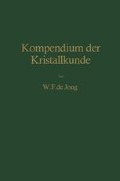Zusammenfassung
Der Name Kristallkunde leitet sich von dem griechischen Wort krystallos ab, womit im Altertum Bergkristall gemeint war. Dieser Bergkristall wird in den hohen Regionen der Alpen in prächtigen Exemplaren gefunden und man glaubte, daß es so stark abgekühltes Eis wäre, daß es nicht mehr schmelzen könne 1.
Access this chapter
Tax calculation will be finalised at checkout
Purchases are for personal use only
Literatur
Geschichtliche Werke: C. M. Marx, Geschichte der Krystallkunde, 1825; F. von Kobell, Geschichte der Mineralogie und Krystallographie, 1866; P. Groth, Entwicklungsgeschichte der mineralogischen Wissenschaften. Berlin, 1926; W. F. de Jong und E. Stradner, Zeittafel. Tschermaks min. u. petr. Mitt. 5 (1956) 362–379.
Author information
Authors and Affiliations
Rights and permissions
Copyright information
© 1959 Springer-Verlag
About this chapter
Cite this chapter
de Jong, W.F. (1959). Einleitung. In: Kompendium der Kristallkunde. Springer, Vienna. https://doi.org/10.1007/978-3-7091-5465-6_1
Download citation
DOI: https://doi.org/10.1007/978-3-7091-5465-6_1
Publisher Name: Springer, Vienna
Print ISBN: 978-3-7091-5466-3
Online ISBN: 978-3-7091-5465-6
eBook Packages: Springer Book Archive

